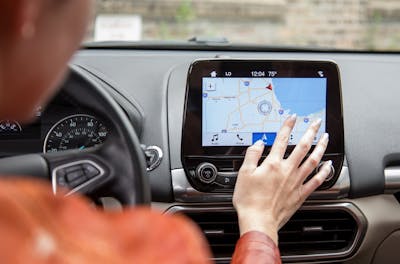GPS stands for Global Positioning System. It is a satellite-based navigation system that provides location and time information in all weather conditions, anywhere on or near the Earth’s surface. GPS was originally developed for the military, but it is now used in many civilian applications, including navigation of vehicles, surveying land, tracking wildlife, and mapping.
GPS stands for Global Positioning System. It is a satellite-based navigation system that provides location and time information to users around the world. The GPS system consists of three segments: the space segment, the control segment, and the user segment.

Credit: www.auto.com
What a Gps Means?
A GPS, or Global Positioning System, is a technology that allows us to pinpoint our exact location on the planet. This system was originally developed by the military for use in navigation and warfare, but has since been made available for civilian use. How does GPS work?
A network of 24 satellites orbits the earth, sending out signals that contain information about their location. GPS receivers pick up these signals and use them to calculate their own position. By triangulating the signal from multiple satellites, the receiver can determine its latitude, longitude, and altitude with great accuracy.
GPS has become an essential tool for everyone from commuters to hikers to sailors. It can be used for turn-by-turn directions, finding businesses and services nearby, tracking fitness progress, and much more.
What are the 3 Types of Gps?
There are three types of GPS systems: ground-based, satellite-based, and hybrid. Ground-based GPS uses a network of ground stations to calculate positions. Satellite-based GPS uses a constellation of satellites in orbit around the Earth to calculate positions.
Hybrid GPS systems use a combination of both ground stations and satellites to calculate positions.
What Does Gps in a Car Stand For?
GPS in a car stands for Global Positioning System. It is a system that uses satellites to determine the location of a vehicle on earth. GPS can be used for navigation, tracking, and even emergency response.
How Does the Gps Work?
GPS, or the Global Positioning System, is a constellation of satellites that orbit the earth. These satellites transmit signals back to earth that can be picked up by GPS receivers. GPS receivers use these signals to calculate the user’s exact location on earth.
The GPS system was originally developed by the US military for use in navigation and missile guidance. However, it is now available for civilian use and has become an essential tool for anyone who needs to know their precise location on earth. How does GPS work?
Each GPS satellite transmits a signal that contains three pieces of information: the satellite’s current position, the time the signal was transmitted, and a unique identification code. GPS receivers use this information to calculate their own position on earth relative to the satellites. By knowing its own position, the receiver can then determine your precise location on earth.
To get started, you need to have at least four visible satellites in order to get a fix on your location. The more satellites you have in view, the more accurate your position will be. Once your receiver has locked onto four or more satellites, it will start calculating your position using trilateration – that is, by measuring the distance between itself and each satellite using the travel time of each satellite’s signal.
From there, your GPS receiver can give you extremely accurate readings of both your latitude and longitude (to within a few meters), as well as your altitude above sea level (to within a few meters). And since most receivers also keep track of local timezone information, they can even tell you what time it is wherever you are in the world!
What does GPS stands for? (And How it Can Track Your Phone)
What Does Gps Stand for in Geography
GPS stands for Global Positioning System. It is a satellite-based navigation system that provides location and time information in all weather conditions, anywhere on or near the Earth’s surface. The U.S. Department of Defense developed and deployed the GPS system, which was originally intended for use by the military.
However, in 1983, President Ronald Reagan decreed that GPS should be available for civilian use once it was completed, and today GPS is used by millions of people around the world every day. There are four main components to the GPS system: satellites, ground stations, receivers, and software. The satellites are orbiting the earth at about 12000 miles above us and transmit signals back down to receivers on the ground.
The ground stations track the satellites and ensure that they are broadcasting correctly. The receivers pick up these signals and use them to calculate their position (latitude, longitude, and altitude) as well as the current time. Finally, the software takes this information and presents it in a usable format like maps or directions.
GPS has many uses beyond just finding your way around town! Scientists use GPS data to study plate tectonics and volcanoes; farmers use it to map their crops; search-and-rescue teams utilize it to find lost hikers; even movie studios have used GPS data to create special effects!
Conclusion
GPS stands for Global Positioning System. It is a space-based satellite navigation system that provides location and time information in all weather conditions, anywhere on or near the Earth’s surface. The system is managed by the U.S. Air Force and is used by the military, government agencies, and civilians around the world.